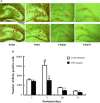Female early adult depression results in detrimental impacts on the behavioral performance and brain development in offspring
- PMID: 22672298
- PMCID: PMC6493584
- DOI: 10.1111/j.1755-5949.2012.00324.x
Female early adult depression results in detrimental impacts on the behavioral performance and brain development in offspring
Abstract
Aims: The present study was to understand whether early adult depressive females implicated their offspring.
Methods: Seven-week-old female mice were subject to chronic mild stress (CMS) to establish the animal model of depression. The behavioral performance of their offspring were tested via neonatal reflexes tests, hole-board test, and morris water maze test in different ages. Astrocyte number, hippocampal volume, and neurogenesis were analyzed via immunohistochemical blotting. Glucocorticoid receptor (GR) expression and serum cortisol levels were measured by western blotting and ELISA.
Results: Female depressive mice had normal fertility, but their offspring had lowered neonatal survival rate and body weight from neonatal period to early adulthood. The offspring of female depressive mice exhibited the impairments of neonatal reflex attainment and memory, but had higher emotionality as adults. Furthermore, the astrocyte number, hippocampal volume, and neurogenesis were reduced in the offspring. However, the expressions of GR were increased in the hippocampus of offspring.
Conclusion: This study reveals that female early adult depressive mice have normal reproductive ability, but make long-term detrimental impacts on the behavioral performance and brain development of their offspring.
© 2012 Blackwell Publishing Ltd.
Conflict of interest statement
The authors declare no conflict of interest.
Figures






Similar articles
-
Gestational and postpartum corticosterone exposure to the dam affects behavioral and endocrine outcome of the offspring in a sexually-dimorphic manner.Neuropharmacology. 2012 Jan;62(1):406-18. doi: 10.1016/j.neuropharm.2011.08.017. Epub 2011 Aug 16. Neuropharmacology. 2012. PMID: 21867716
-
Sex-specific deficits in biochemical but not behavioral responses to delay fear conditioning in prenatal alcohol exposure mice.Neurobiol Learn Mem. 2018 Dec;156:1-16. doi: 10.1016/j.nlm.2018.10.002. Epub 2018 Oct 12. Neurobiol Learn Mem. 2018. PMID: 30316893 Free PMC article.
-
Transgenerational impairment of hippocampal Akt-mTOR signaling and behavioral deficits in the offspring of mice that experience postpartum depression-like illness.Prog Neuropsychopharmacol Biol Psychiatry. 2017 Feb 6;73:11-18. doi: 10.1016/j.pnpbp.2016.09.008. Epub 2016 Sep 28. Prog Neuropsychopharmacol Biol Psychiatry. 2017. PMID: 27693392
-
Iptakalim confers an antidepressant effect in a chronic mild stress model of depression through regulating neuro-inflammation and neurogenesis.Int J Neuropsychopharmacol. 2014 Sep;17(9):1501-10. doi: 10.1017/S1461145714000285. Epub 2014 Mar 13. Int J Neuropsychopharmacol. 2014. PMID: 24621884
-
Emodin opposes chronic unpredictable mild stress induced depressive-like behavior in mice by upregulating the levels of hippocampal glucocorticoid receptor and brain-derived neurotrophic factor.Fitoterapia. 2014 Oct;98:1-10. doi: 10.1016/j.fitote.2014.06.007. Epub 2014 Jun 14. Fitoterapia. 2014. PMID: 24932776
Cited by
-
Glymphatic Dysfunction: A Bridge Between Sleep Disturbance and Mood Disorders.Front Psychiatry. 2021 May 7;12:658340. doi: 10.3389/fpsyt.2021.658340. eCollection 2021. Front Psychiatry. 2021. PMID: 34025481 Free PMC article.
-
Establishment of depression behavioral criteria in cynomolgus monkeys.CNS Neurosci Ther. 2013 Nov;19(11):911-3. doi: 10.1111/cns.12177. Epub 2013 Oct 14. CNS Neurosci Ther. 2013. PMID: 24118874 Free PMC article. No abstract available.
-
Brain NMDA Receptors in Schizophrenia and Depression.Biomolecules. 2020 Jun 23;10(6):947. doi: 10.3390/biom10060947. Biomolecules. 2020. PMID: 32585886 Free PMC article. Review.
-
Glymphatic System Dysfunction in Central Nervous System Diseases and Mood Disorders.Front Aging Neurosci. 2022 Apr 25;14:873697. doi: 10.3389/fnagi.2022.873697. eCollection 2022. Front Aging Neurosci. 2022. PMID: 35547631 Free PMC article. Review.
-
LncRNA Gm14205 induces astrocytic NLRP3 inflammasome activation via inhibiting oxytocin receptor in postpartum depression.Biosci Rep. 2020 Aug 28;40(8):BSR20200672. doi: 10.1042/BSR20200672. Biosci Rep. 2020. PMID: 32706026 Free PMC article.
References
-
- Miyagawa K, Tsuji M, Fujimori K, Saito Y, Takeda H. Prenatal stress induces anxiety‐like behavior together with the disruption of central serotonin neurons in mice. Neurosci Res 2011;70:111–117. - PubMed
-
- Noble RE. Depression in women. Metabolism, 2005;54: 49–52. - PubMed
-
- Silverstein B. Gender differences in the prevalence of somatic versus pure depression: A replication. Am J Psychiatry 2002;159:1051–1052. - PubMed
-
- Timur S, Sahin NH. The prevalence of depression symptoms and influencing factors among perimenopausal and postmenopausal women. Menopause 2010;17:545–551. - PubMed
Publication types
MeSH terms
Substances
LinkOut - more resources
Full Text Sources
Medical

